|
|
|
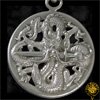 |
|
| Hanwei Dragon Pendant (OH3037S) |
Points: 2


|
These tsuba pendant necklaces from CAS Hanwei are crafted in sterling silver and represent iconic tsuba designs from our line of Japanese Katana. The one non-tsuba style may be recognized as the dragon from the CAS Hanwei logo! The braided neck bands feature a unique sliding closure that allows for a full range of length adjustment. Each piece is packaged in an upscale clam shell jewelry box creating an exceptional gift for the martial artist or sword collector.
Sold Out
|
|
|
|
|
|
 |
|
|
|
|
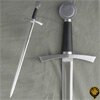 |
|
| Hanwei Lionheart Sword (SH2367) |
Points: 11

|
The single-hand Lionheart Sword is typical of the cruciform-hilt style of the crusading knights of Europe in the 12th and 13th centuries. The wheel pommel and slightly turned-down bow-tie guard make this a very attractive sword indeed! Iberia Swords are crafted in much the same way as swords were made centuries ago, except that the blades are now forged from high-carbon spring steel, a resource unavailable off-the-shelf to the smiths of the old. The blade finish is far from being polished, again more closely replicating what the medieval swordsmith was able to achieve. Except as noted, grips are leather-covered hardwood. Fittings are either steel or solid brass. Except, where shown all of these swords have scabbards of leather-covered fiberglass with steel lockets and chapes and removable suspension rings. These swords will appeal to the re-enactor who wants a sword with the same appearance as the originals.
Sold Out
|
|
|
|
|
|
 |
|
| Hanwei Henry V Sword (SH2369) |
Points: 11

|
The Henry V Sword is modeled after the sword hung over the tomb of one of England's great warrior kings. The single-handed cut-and-thrust weapon combines a relatively short sturdy blade with elegant down-swept quillons and a wheel pommel. Iberia Swords are crafted in much the same way as swords were made centuries ago, except that the blades are now forged from high-carbon spring steel, a resource unavailable off-the-shelf to the smiths of the old. The blade finish is far from being polished, again more closely replicating what the medieval swordsmith was able to achieve. Except as noted, grips are leather-covered hardwood. Fittings are either steel or solid brass. Except, where shown all of these swords have scabbards of leather-covered fiberglass with steel lockets and chapes and removable suspension rings. These swords will appeal to the re-enactor who wants a sword with the same appearance as the originals.
Sold Out
|
|
|
|
|
|
 |
|
| Hanwei Agincourt Sword (SH2371) |
Points: 11

|
The Agincourt, an English-style single-hand sword, commemorates one of the memorable battles of the Hundred Year's War between England and France. Iberia Swords are crafted in much the same way as swords were made centuries ago, except that the blades are now forged from high-carbon spring steel, a resource unavailable off-the-shelf to the smiths of the old. The blade finish is far from being polished, again more closely replicating what the medieval swordsmith was able to achieve. Except as noted, grips are leather-covered hardwood. Fittings are either steel or solid brass. Except, where shown all of these swords have scabbards of leather-covered fiberglass with steel lockets and chapes and removable suspension rings. These swords will appeal to the re-enactor who wants a sword with the same appearance as the originals.
Sold Out
|
|
|
|
|
|
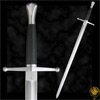 |
|
| Hanwei War Sword (SH2366) |
Points: 11

|
The War Sword is a hand-and-a-half design from the early 14th century. The hardwood grip and elongated scent-stopper pommel make the 32" blade surprisingly easy to handle. Iberia Swords are crafted in much the same way as swords were made centuries ago, except that the blades are now forged from high-carbon spring steel, a resource unavailable off-the-shelf to the smiths of the old. The blade finish is far from being polished, again more closely replicating what the medieval swordsmith was able to achieve. Except as noted, grips are leather-covered hardwood. Fittings are either steel or solid brass. Except, where shown all of these swords have scabbards of leather-covered fiberglass with steel lockets and chapes and removable suspension rings. These swords will appeal to the re-enactor who wants a sword with the same appearance as the original.
Sold Out
|
|
|
|
|
|
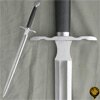 |
|
| Hanwei Hand and a Half Sword (SH2365) |
Points: 11

|
Hand-and-a-Half Sword, this version of a 16th century piece are a longtime favorite. Balance is excellent, providing a sword which lends itself to both single and two-handed use. Iberia Swords are crafted in much the same way as swords were made centuries ago, except that the blades are now forged from high-carbon spring steel, a resource unavailable off-the-shelf to the smiths of the old. The blade finish is far from being polished, again more closely replicating what the medieval swordsmith was able to achieve. Except as noted, grips are leather-covered hardwood. Fittings are either steel or solid brass. Except, where shown all of these swords have scabbards of leather-covered fiberglass with steel lockets and chapes and removable suspension rings. These swords will appeal to the re-enactor who wants a sword with the same appearance as the originals.
Sold Out
|
|
|
|
|
|
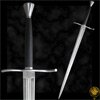 |
|
| Hanwei Mercenary Sword (SH2368) |
Points: 13

|
The Mercenary is an imposing sword in the 15th century style. It featuring a triple-fullered blade, steel S-curve guard and scent stopper pommel. Supplied with a leather-covered belt scabbard. Iberia Swords are crafted in much the same way as swords were made centuries ago, except that the blades are now forged from high-carbon spring steel, a resource unavailable off-the-shelf to the smiths of the old. The blade finish is far from being polished, again more closely replicating what the medieval swordsmith was able to achieve. Except as noted, grips are leather-covered hardwood. Fittings are either steel or solid brass. Except, where shown all of these swords have scabbards of leather-covered fiberglass with steel lockets and chapes and removable suspension rings. These swords will appeal to the re-enactor who wants a sword with the same appearance as the originals.
Sold Out
|
|
|
|
|
|
 |
|
| Hanwei Bastard Sword (SH2250N) |
Points: 11

|
The Swiss and Germans originally carried these weapons, although Bastard swords soon became popular in other regions such as the British Isles and Europe. The term Bastard undoubtedly comes from the fact that the sword, because of its design, has no legitimate claim to being classified as either a uniquely single-handed or two-handed weapon. The Bastard sword was a weapon developed for the use of the foot soldier and had became quite common by the early 1500's. The combat styles developed for the Bastard sword were the particular specialty of the Northern European cultures, with the Germanic nations being at the forefront in its development and use. Our Bastard Sword is finished in an antique patina, making for an outstandingly authentic appearance. The included scabbard features metal chape and tip in the same patina as the furniture with a solid wood core.
Sold Out
|
|
|
|
|
|
 |
|
| Hanwei Rhinelander Bastard Sword (SH2454) |
Points: 11

|
Our Rhinelander Bastard sword, typical of late 15th century central European cut-and-thrust swords, is a handsome piece that will be appreciated by both collectors and cutting enthusiasts.
The ring-guard hilt and scent-stopper pommel balance a riveted-tang fullered blade, forged in 5160 high-carbon steel and hardened to 54HRC for an optimal combination of edge-holding and resilience. A leather-wrapped scabbard is included.
Sold Out
|
|
|
|
|
|
 |
|
| Hanwei Medieval Sword Crecy (SH2455) |
Points: 24

|
Our Crecy single-hand sword, celebrating the first major battle, in 1346, of the hundred years war between England and France, is styled after an early 14th century original. The riveted-tang blade, forged in 5160 high-carbon steel, features a prominent central ridge that provides the necessary stiffness for forceful thrusts, while the stylish hilt features slightly down-turned quillons and a cord-wrapped grip. The handsome scabbard, finished in chestnut leather, is a fitting complement to the sword.
Sold Out
|
|
|
|
|
|
 |
|
| Hanwei Longsword - Tinker Pearce Sharp (SH2394) |
Points: 15

|
Tinker Pearce has developed these matching longswords to satisfy the need of every Western Martial Arts practitioner and sword enthusiast, to have a matching set of sharp and blunt swords for cutting and safe training practice. The swords meet Tinker`s exacting quality requirements and are built in much the same way as his custom pieces. Each blade is forged from 5160 Spring Steel, Marquenched to the desired hardness of 50-53 Hrc while the tang is drawn back to the low 30s Hrc. The very end of the tang is threaded to fit an allen nut recessed into the pommel which allows for dimantling of the hilt assembly for inspection or to exchange blades if needed.
Sold Out
|
|
|
|
|
|
 |
|
| Hanwei Gustav Rapier Antiqued (SH2206N) |
Points: 12
|
The Gustav Rapier and Main Gauche replicate weapons used by King Gustav Adolf II, who ruled Sweden in the early part of the 17th century. The shell guard of the rapier is unusual but effective. Available in both bright and antiqued versions. A replacement live blade is also available (OH2327).
All of our rapiers have stainless steel hilts, for reduced maintenance, and high-carbon steel flex-tempered blades. Our three swept-hilt styles (Solingen, Torino, Gustav) are available with hilts in both polished and antiqued finishes. The latter finish, developed by Hanwei, has allowed a museum-quality patina to be applied to stainless steel while the non-corroding properties of the steel are retained. This finish is extremely attractive and gives a very authentic appearance to the piece.
Sold Out
|
|
|
|
|
|
 |
|
| Hanwei Taza Cup Hilt Rapier (SH2035) |
Points: 12

|
Long extolled as the pinnacle of rapier design, the "Spanish" or "Cup-Hilt" rapier undoubtedly combined style and function very effectively in 17th century Europe. The very best of these weapons featured beautifully pierced cups and pommels and CAS Hanwei has replicated these to perfection and combined them with an elegantly tapered high-carbon steel blade in our "Taza" rapier (the name comes from the French, who called this style "a la Taza"). A leather-covered scabbard is included.
The matching Main Gauche again features a pierced guard and pommel in the same design as the rapier, with a fileworked blade in the Spanish style. A leather scabbard and belt frog are included.
Sold Out
|
|
|
|
|
|
 |
|
| Hanwei Taza Rapier (Antiqued) (SH2035N) |
Points: 14
|
Long extolled as the pinnacle of rapier design, the "Spanish" or "Cup-Hilt" rapier undoubtedly combined style and function very effectively in 17th century Europe. The very best of these weapons featured beautifully pierced cups and pommels and CAS Hanwei has replicated these to perfection and combined them with an elegantly tapered high-carbon steel blade in our "Taza" rapier (the name comes from the French, who called this style "a la Taza"). A leather-covered scabbard is included.
The matching Main Gauche again features a pierced guard and pommel in the same design as the rapier, with a fileworked blade in the Spanish style. A leather scabbard and belt frog are included.
Sold Out
|
|
|
|
|
|
|
|
Tags:
swords, sword, katana, wakizashi, tanto, japanese sword, medieval sword, viking sword, japanese swords, medieval swords, viking swords, knife, knives, saber, armour, movie swords, movie replicas, martial arts, sporting goods, sporting equipment,
|
















